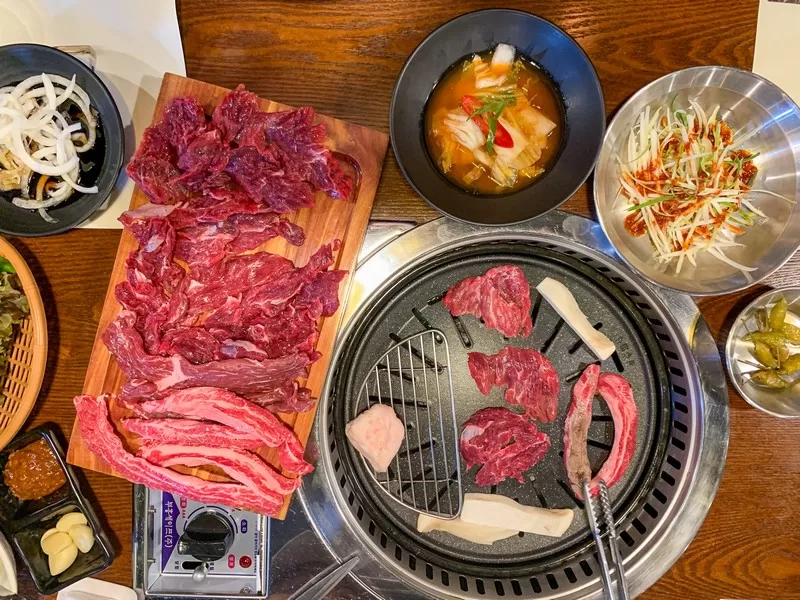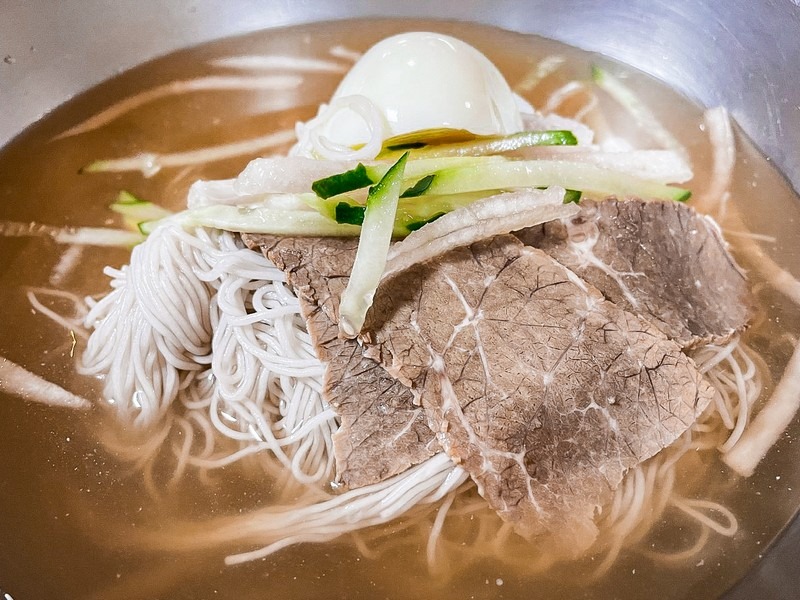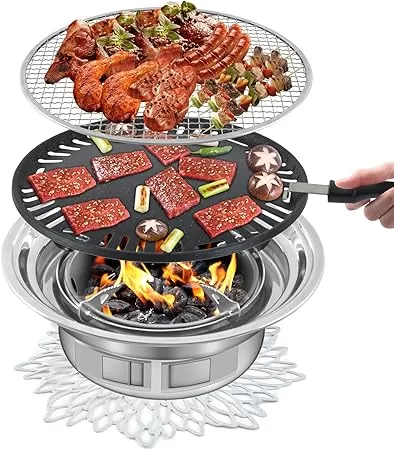How To Eat Korean BBQ: What To Expect When Eating In Korea
Last Updated on March 21, 2025
Korean barbecue might seem a bit intimidating if it’s your first time, but don’t worry, it’s as much about the experience as it is about the food! Whether you’re seated at a table with friends or enjoying it with coworkers, you’re in for a tasty adventure. Before you can begin that adventure though, you need to know how to order meat, what to expect at a Korean barbecue restaurant, and then you can reap the delicious rewards.
What makes Korean BBQ so popular, especially for first-time visitors to Korea, is not just the high-quality, flavorful cuts of meat, but the immersive nature of the entire dining process. But, like I said, it can be a lot to take in, so here’s what to expect from ordering to eating.

Korean barbecue is the dining experience to have in Korea. It can be a lot though. Here’s what to expect:
- Korean Barbecue Is A Communal Event
- How To Eat At A Korean Barbecue Restaurant: Step By Step
- Where To Eat Korean BBQ In Seoul
(This post contains affiliate links, which means I receive a certain percentage of a sale if you purchase after clicking at no cost to you. Thank you for your support.)

Korean Barbecue Is A Communal Event
In Korea, meals are often enjoyed in groups, with family, friends, or colleagues sitting around a table. This is important to note as some barbecue restaurants won’t let a single diner order which is something any solo traveler should be aware of. Of course, there are some restaurants that will be fine with it, but you’ll have to order at least enough for two. Ready to dig in?
The act of grilling your own food allows everyone to be involved, and it gives each person the freedom to cook their meat exactly how they like it. Whether you’re a fan of slightly crispy pork belly or perfectly tender bulgogi, Korean BBQ lets you be the master of your meal. It’s a bonding experience that encourages conversation, laughter, and sharing.
How To Eat At A Korean Barbecue Restaurant: Step By Step
Choose Your Meat
I think ordering at a Korean barbecue restaurant can really be the most intimidating aspect of the experience. I never knew much about meat and the different cuts before coming to Korea, but I certainly know which cuts I enjoy most now.
You’ll have options like samgyeopsal (pork belly), galbi (marinated short ribs), or bulgogi (marinated beef) among plenty of others. Take your time and pick what looks best—after all, this is where the magic begins.
Korean Meat Vocabulary

Pork Cuts
- 삼겹살 (Samgyeopsal): Pork belly, the most popular cut. Juicy and flavorful.
- 목살 (Moksal): Pork neck, leaner than samgyeopsal, so it requires careful grilling.
- 한정살 (Hangjeongsal): A tender, rarer pork neck cut, pricier and quick to cook.
- 가브리살 (Gabeulisal): Pork cheek, very tender and expensive. Grill carefully to avoid burning.
- 돼지껍데기 (Dwaejigeopddaegi): Pork skin or pork rinds, crispy and rich in collagen, often enjoyed toward the end of the meal.
Fun Fact: In Korean, there is a saying “one head with 100 tastes” (일두백미) which refers to the fact that one cow can be cut to create 100 different tastes. While US beef cuts are usually around 22, Korean beef cuts are around 120!

Beef Cuts:
- 한우 (Hanwoo): Premium Korean beef with a distinct taste, but pricey.
- 차돌박이 (Chadolbagi): Thin beef brisket, cooks quickly and pairs well with sesame oil and salt.
- 든심 (Deungshim): Soft, fatty sirloin that melts in your mouth.
- 안창살 (Anchangsal): Outside skirt, tender, thin, and flavorful. Our personal favorite.
- 안심 (Anshim): Beef tenderloin, thick and juicy. Usually cooked by staff for the best result.
- 살치살 (Salchisal): Rare chuck tail flap, thin steak with rich flavor.
- 대창 (Daechang): Soft, chewy beef large intestines, a bit oily.

Yukhoe (육회) is Korea’s version of steak tartare. Thinly sliced raw beef is marinated in soy sauce, garlic, sesame oil, and seasonings, then topped with a raw egg and crisp Korean pear. It’s all mixed tableside into a flavorful blend—soft and delicious.
Could be pork or beef, make sure to ask:
- 갈비 (Galbi): Marinated ribs, ask if they’re pork or beef. Sweet and kid-friendly. It’s often a great choice for Korean food if you have kids.
- 불고기 (Bulgogi): Thinly sliced beef marinated in a sweet and savory sauce. Also a kiddo favorite.
- 곱창 (Gopchang): Small intestines, either pork or beef, often stir-fried with a strong flavor.
- 막창 (Makchang): This can either be the cow’s fourth intestine or the pig’s last intestine. Lean and juicy, usually pricier.
Did you know: Not all bulgogi is served the same. While it’s often served in a broth or liquid, if you visit Yeokjeon Hoegwan near Gongdeok Station, you can dry the unique version of bulgogi they’ve been making since the 60s.

Fire Up The Grill
Once you’ve made your selection, the staff will fire up the grill right at your table. Korean barbecue restaurants can have gas, charcoal, or portable stove grills that they bring to your table.
If the table itself doesn’t have a built in grill with gas that feeds into it, a waiter will bring over a large fiery coal that will be placed in the center of the table. Make sure to watch out and don’t wave your hands around while they’re doing this.
Want have a Korean barbecue at home?

Decide Who Holds The Tongs
If you’re in Korea, you’ll likely be the one doing the grilling, though if the staff notice that you don’t know what you’re doing, they may also shuffle over to assist because no one wants their good meats going to waste.
While the majority of restaurants are cook-it-yourself, there are some restaurants that have staff always on-hand to cook for you. Just depends where you go. Either way, listen to that sizzle as the meat hits the grill—it’s like a soundtrack to a delicious meal.


How To Eat Korean Barbecue
Flip the meat to get that perfect char, and once it’s ready, you’ll want to dive into the art of ssam, or the lettuce wrap. This involves wrapping your grilled meat in lettuce and perilla leaves (but called sesame leaves in Korea), adding a sauce, some side dishes and enjoying the bite.
Tip: When it comes to taking that bite, make sure you shove the whole thing in your mouth in one go. You’re not supposed to take bites of your wrap. It’s one-go or no-go.
Personally, my first bite is always just the meat on it’s own so I can taste the goodness. I like a good ssam, but the reason we go out is for the meat so I taste it first, in all its glory.
Ultimately, it all comes down to personal taste. My husband taught me that the best way to enjoy Korean food is simply to dive in and eat it. While there may be specific recommendations on how to enjoy a dish, the most important thing is to savor it in whatever way makes you happiest.
Common Dipping Sauces and Seasonings
Ssamjang
You’ll notice a red sauce on the table. This is ssamjang and it’s a sauce made from soybean paste, or doenjang, hot pepper paste, or gochujang, sugar, green onions, garlic, and toasted sesame seeds.
Sesame oil, Salt, Pepper
This savory option is my favorite as it lets the meat really shine through. Also an option is to just have salt without the sesame oil, my daughter’s favorite.

Side Dishes, Soups, and Steamed Eggs Oh My
Don’t forget about the side dishes, or banchan. These small plates add layers of flavor, from the tanginess of the onions to the spiciness of the kimchi. Each banchan is designed to complement the grilled meat, providing a refreshing contrast to the rich flavors of the barbecue.
You’ll often find that Koreans enjoy mixing and matching these side dishes with every bite, creating endless combinations of flavors and textures. Don’t be afraid to experiment with everything that’s on the table to find your favorite combination.


After The Meat, There’s More
After the meat is gone, you might think the end of the meal has come, but wait!, there is potentially more. Many restaurants will also have naengmyeon or bibimnaengmyeon on the menu. These are very refreshing cold noodle dishes that are the perfect crisp way to end a meat-heavy meal.
Combining julienned cucumbers, sliced Korean pear, radish, and a boiled egg or cold boiled beef, spicy mustard and vinegar make the broth quite tangy. Save a few pieces of meat from the grill to eat it in combination. It’s delicious!
Where To Eat Korean BBQ In Seoul
To be perfectly honest, you can have great Korean barbecue all over the city of Seoul. Our personal favorite is right in our neighborhood in Eunpyeong-gu. It’s a neighborhood favorite and always packed with locals. All of that to say, follow your nose if you want to eat barbecue in Seoul.
If you’re staying in downtown Seoul, head over to the popular Ikseon-dong district to find Gogi Street, or Meat Street. Suffice to say, there are a lot of places to dive into the Korean BBQ experience.


Yeonnam Seo Sikdang (연남서식당)
Opened in 1953 just after the Korean War, don’t plan to sit if you’re heading to eat here. One of the oldest restaurants in Seoul, this is the spot for a unique Korean barbecue meal in Seoul.
It’s an experience, but don’t expect a ton of sides. Since the table is a grill, you pretty much just get the meat and drinks. If you want something more, you’ll have to bring it yourself.
- Address: 15 Yeonhuimat-ro, Seodaemun-gu, Seoul (서울시 서대문구 연희맛로 15)*
- If you’ve been before and thought it was in a different location, you’re right. It moved in 2022 so the address listed above where it is now established.
- Hours: Tuesday – Sunday: 11:30am ~ 6:30pm
Mapo Jinjja Wonjo Choidaepo (마포진짜원조최대포)
Opened in 1956, if you visit, be sure to walk around a bit. There are some great things to do in Gongdeok and a lot of people really overlook the area. If you like Korean bbq, you’ll like what they’ve got on order; pork ribs, pig skin, and all the fixins.
- Address: 112-4 Mapo-daero, Mapo-gu, Seoul (서울시 마포구 마포대로 112-4)
- Hours: Every day: 11:00am ~ 11:00pm


Woorae-ok (우래옥)
Well-known for their Pyeongyang naengmyeon that even President Obama enjoyed, Woorae-ok opened in 1946 and is firstly a fantastic Korean BBQ restaurant. This place always has a line so get there early and just be prepared for a bit of a wait. Is it worth it though? Yes it is. Go hungry!
- Address: 62-29 Changgyeonggung-ro, Jung-gu, Seoul (서울 중구 창경궁로 62-29)
- Hours: Tuesday – Sunday: 11:30am ~ 9:00pm
No matter where you go, you’ll feel the energy of the place—people chatting, drinks clinking, and the constant sizzle of meat on the grill. It’s an experience that’s lively, dynamic, and quintessentially Korean.
Did you like this post? Pin IT!





